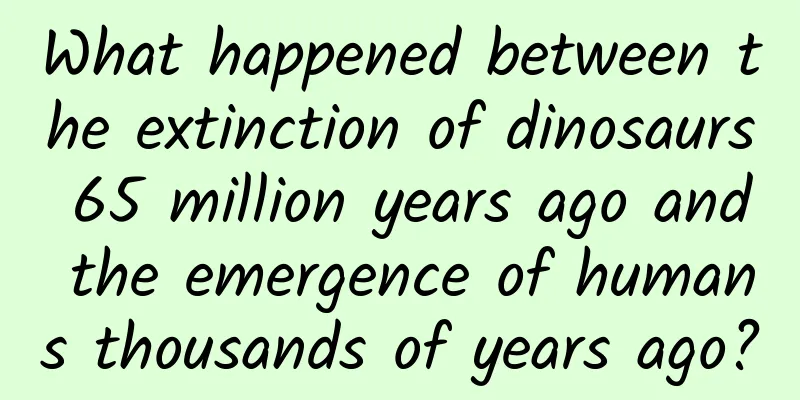What happened between the extinction of dinosaurs 65 million years ago and the emergence of humans thousands of years ago?

|
This article is based on answering similar questions from netizens: Dinosaurs became extinct 65 million years ago, and human civilization has only a few thousand years of history. What happened in the blank period in between? In fact, there are two misunderstandings about this question. First, although the history of human civilization is only a few thousand years, the history of human evolution is tens of millions of years; therefore, there is no "blank in the middle" in these tens of millions of years, but a rich history of species evolution. Now let's study and discuss what happened and experienced during this period. The Cretaceous extinction process Current scientific research has found that life has appeared 3.7 billion years ago, but early life was all microorganisms. Although they cannot be seen by the naked eye, they changed the environment of the Earth. For example, the outbreak of bacteria and algae formed the Great Oxidation Event on Earth, thus creating conditions for the emergence of aerobic animals and plants. It was not until the Cambrian period 542 million years ago that life began to diversify, mainly in the oceans. Therefore, the scientific community divides the evolution of the Earth into the Hadean Eon and the Phanerozoic Eon, with the Cambrian period as the boundary. The period before was called the Hadean Eon, when life appeared in a form that was invisible to the naked eye; the period after was called the Phanerozoic Eon, when life appeared in a visible form. The so-called five mass extinctions began after entering the Phanerozoic. No one has counted how many extinctions occurred in the Hadean era before. The so-called mass extinction is due to the geological activities of the earth, the solar activities, and the activities of life itself, which changed the living environment of the earth, making it impossible for the old generation of organisms to continue, thus resulting in the phenomenon of generation gap and rebirth. There were five mass extinction events, each of which wiped out 70 to 90% of the old species. The surviving species evolved and became new species that adapted to the new environment and climate. After a period of prosperity, the Earth would encounter new changes again. The evolution of organisms also proceeds in waves. The extinction of dinosaurs belongs to the fifth mass extinction of species, also known as the Cretaceous extinction. The Phanerozoic Era is divided into the Paleozoic, Mesozoic and Cenozoic Eras, and the dinosaur era belongs to the Mesozoic Era. The extinction of dinosaurs symbolizes the end of the Mesozoic Era, and the rise of mammals afterwards symbolizes the beginning of the Cenozoic Era. Today we will not discuss how the dinosaurs became extinct, but the fact is that the dinosaurs did not disappear all at once. After the asteroid that was thought to have destroyed the dinosaurs hit, the surviving dinosaurs continued to survive for millions of years. In the long period of natural changes, large dinosaurs gradually became extinct, and some dinosaurs (mainly theropod dinosaurs that adapted to survival and evolved into miniaturized ones) evolved into birds. Therefore, paleontologists believe that dinosaurs are the ancestors of modern birds. It can also be believed that dinosaurs did not become extinct, but rather partially evolved. However, the Cretaceous extinction did not affect only the dinosaurs, but about 80% of species, including marine life, reptiles, microorganisms, plants, etc. The main reasons for the extinction were environmental changes and the impact smoke blocking the sun, causing the plants and marine microorganisms that rely on photosynthesis to survive to die first, followed by a series of chain species extinction events caused by the breakdown of the food chain. The extinction of dinosaurs provided conditions for the rise of mammals Every mass extinction is actually a great restart of life. Every restart is a transformation of life from simple to complex, from low to high. In this sense, without mass extinction, there would be no human beings today. Therefore, we do not need to regret the mass extinction of dinosaurs. If these behemoths still ruled the earth, there would be no human beings. Human civilization with written records is only a few thousand years old, which does not mean that humans suddenly appeared thousands of years ago, but rather that they went through a long evolutionary process. In fact, the ancestors of humans began to evolve into modern humans before the extinction of dinosaurs. Mammals are more advanced animals than reptiles, and humans belong to mammals, so the ancestors of mammals are also the ancestors of humans. Mammals were born quietly in the dinosaur era, but due to the rampant reptiles, these mammals could only hide underground or in some secret corners, enduring humiliation and living. A fossil of the Chinese Jurassic beast was unearthed in Liaoning, China. After the restoration of its body, it is a bit like a mouse today, but much smaller, weighing only 13 grams, and has the ability to climb trees and escape on the ground. This is considered by scientists to be the earliest mammal, and therefore the ancestor of mammals. Because it was unearthed in Liaoning, it was named the Chinese Jurassic Mother. The most obvious sign of mammals is that they feed their young through the secretion of milk through mammary glands. After the extinction of dinosaurs, life restarted and mammals ushered in the spring of development, differentiating into three branches: Prototheria, Eutheria and Metatheria, among which Eutheria is the mainstream of mammals. Eutheria is a group of vertebrates with the most complex body structure, functional behavior, and a wide variety of species, accounting for about 95% of existing mammals. This type of animal is characterized by conception and live birth in the mother's body, which greatly improves the safety of offspring reproduction and is a great progress in animal evolution. During the evolution, the Eutheria differentiated into 20 orders, namely, Artiodactyla, Perissodactyla, Carnivora, Chiroptera, Pholidota, Shrews, Hedgehogs, Afrostgiformes, Lagomorpha, Rodentia, Tubulodonta, Primates, Elephant Shrews, Tree Shrews, Phalaropedia, Scutellaria, Dermaptera, Hyraxidae, Proboscidea, and Sirenia. Each order is further divided into families, genera, species, etc., so there are many species under each order, such as Artiodactyla, which means the hoof has an even number of toes (even), such as pigs, cattle, sheep, deer, etc.; Perissodactyla, which means the hoof has an odd number of toes (single), such as horses, rhinos, etc.; Carnivora, such as tigers, lions, wolves, dogs, etc.; Rodents, such as mice, squirrels, guinea pigs, etc. Humans belong to the order Primates, the suborder Anthropoides, the family Hominidae, the genus Homo, and the species Homo sapiens. Primates have 2 suborders, 16 families, about 78 genera, and more than 514 species. Compared with other mammals, primates have much larger brains and rely on stereoscopic perception to observe things, so they are the smartest mammals. However, primates' sense of smell and hearing are not as good as most other animals. The general outline of human evolution Humans gradually differentiated from primates. As early as more than 50 million years ago, primates experienced explosive radial evolution and differentiation, and higher primates, that is, smarter animals and monkeys, such as macaques, golden monkeys, baboons, and apes, differentiated from lower primates. About 33 million to 24 million years ago, apes emerged from the monkeys of the ancient world, and gradually differentiated into forest apes and Proconsulpithecus. These apes were forest apes that walked on all fours and were good at climbing trees. Between 15 million and 12 million years ago, African apes and Asian apes were differentiated. African apes are the ancestors of modern gorillas, chimpanzees and humans, while Asian apes are the ancestors of modern gibbons and orangutans. From modern fossil excavations and research, scientists have obtained fossil representatives of two transitional apes, one is Ramapithecus and the other is Australopithecus. The age of these fossils ranges from 10 million to 2 million years ago. The Australopithecus among them is considered to be the descendant of African apes, the ancestor of humans, and the humans in the process of formation. 12 million years ago, the crustal movement formed a large rift valley in the eastern part of Africa, dividing the continent into two major parts, the east and the west. The animals living in these two parts also became two independent systems, which became the key to the separation of humans and apes. The west was still covered with dense and humid jungles, and the environment had not changed much, so the apes living there did not need to make drastic changes to survive. As a result, they were content with the status quo and stopped evolving towards intelligence. However, rainfall in the east gradually decreased, forests gradually disappeared and grasslands appeared. Most of the ape ancestors became extinct because they could not adapt to the changes in the environment. A small number of tenacious apes began to learn survival skills in the new environment of open areas, forming a unique evolutionary pattern. The real dividing point between humans and animals was between 8 million and 5 million years ago. Modern genetics, through the study of DNA differentiation, believes that the history of hominids began at this time, that is, when humans parted ways with their closest relatives, chimpanzees, walked out of the jungle, and began to establish settlements in the savanna (grassland with very sparse trees). By 2.5 million years ago, the climate in Africa had further deteriorated, and most Australopithecus disappeared. A small number of Australopithecus learned some survival mechanisms, such as using fire and throwing stones, and making primitive weapons with materials such as branches. In this way, they survived and reproduced, and eventually evolved into humans, from living in trees to becoming bipedal human ancestors. With the beginning of a new life, the language system of human ancestors, which was based on concepts, became more and more complex. This thinking tool allowed the early ancient humans to improve their self-awareness and thinking memory by leaps and bounds, and humans finally appeared. At first, various human races appeared in many regions, such as Heidelberg Man, Neanderthal Man, Homo Habilis, Homo erectus, etc., as many as fifteen or sixteen species. Later, in the competition for survival, these human races disappeared, and only Homo sapiens was left, which is the ancestor of modern humans. Ancient humans gradually transformed into modern humans during migration/ The ancestors of Homo sapiens appeared in East Africa around 250,000 years ago. At that time, there was no distinction between white, black, and yellow people. It was not until around 100,000 years ago, mainly 70,000 years ago, that these Homo sapiens began to migrate to various parts of the world and eventually formed modern humans who are now spread all over the world. Various skin colors and appearances were formed through the long-term evolution in different living environments. Modern genetics tracking research has provided a clearer picture of human evolution and migration. A DNA study by the School of Life Sciences of Fudan University has shown that the Chinese population was a group of South Asian people with the M122 mutation gene who entered the current Chinese territory from Myanmar in Southeast Asia 30,000 to 40,000 years ago through two entrances, one in Yunnan and the other in the Pearl River Basin. After entering Yunnan, the group split into two routes, forming three migration routes overall. Among the more than 50 ethnic groups in China, the Han and Tibetan peoples are the closest in blood relationship. They share the same origin, but only began to gradually form different ethnic groups due to geographical environment 5,000 years ago. Mitochondrial DNA in human cells carries a unique genetic code that can only be passed on to the next generation by the mother. This genetic code is difficult to change, and generally only a slight change occurs every 20,000 years, so it has become a beacon for tracking genetic genes. Through the study of modern human mitochondrial DNA, scientists have discovered an astonishing secret: all the world's population comes from one mother! This means that after humans migrated out of Africa, they gave rise to 7.9 billion people around the world, but only one ancestor mother's genes were inherited. People named this great ancestor mother "Mitochondrial Eve." This does not mean that only this mother left Africa, but that after several generations of reproduction, there were no daughters left. Further research found that among the descendants of "Mitochondrial Eve" there are 36 "clan mothers" who lived between 10,000 and 45,000 years ago. Now, regardless of the skin color of people around the world, they are descendants of these 36 "clan mothers." Therefore, there is no blank in history, and evolution is always on the road. Not only humans, but all species have been evolving for tens of millions of years. All species today are no longer the same as they were tens of millions of years ago. It’s just that humans are the biggest variable in this wave of evolution, the only intelligent creatures that have stood out and developed human civilization. But evolution never stops and is always on the way. It’s just that nature’s modification of species is very slow. After hundreds, thousands or even tens of thousands of years, the changes will not be very big. Only after millions or tens of millions of years of vicissitudes, the changes in species are very obvious. Many species become extinct and many new species are born. Humans are still evolving. If you observe and study carefully, you will find that people 1,000 or even 100 years ago are different from modern people. This is because the living environment and lifestyle are different, and their aesthetic values are also different. People will evolve in the direction of adapting to the environment and aesthetics. In ancient times, people’s physical labor was very intense, and their living conditions were poor, so their average stature was relatively small, their average lifespan was relatively short, and their body structure was also different. But now people’s physical labor is getting less intense, their mental labor is getting bigger, their living conditions are getting better, their stature is getting taller, and their lifespan is getting longer. Ancient aesthetics required men to have big ears, broad backs and strong waists, and women to have faces like full moons, that is, to be plump; many foods in ancient times needed to be chewed with teeth, so people at that time had wide and hard jawbones. Modern aesthetics pursues a thin and slender figure, and handsome men and beautiful women want to have fresh meat and cone-shaped faces, which is very different from the ancients; nowadays, food is becoming more and more refined, and teeth are used less and less. Although they are getting better and better, and some people even wear braces, they are less able to chew hard things, so the chin is naturally getting more and more pointed. These are actually small changes. After 10,000 years, if humans are not extinct, they may already exist in the form of consciousness, becoming invisible but omnipresent, and immortal. So, as long as you live long enough, you can see these changes. Are you willing to wait? Welcome to discuss, thank you for reading. The copyright of Space-Time Communication is original. Please do not infringe or plagiarize. Thank you for your understanding and cooperation. |
<<: "It's a miracle that she's still alive"
>>: What is the world's "fastest" flower found on the Qinghai-Tibet Plateau?
Recommend
C4D tutorial 105 episodes
This set of C4D example tutorials has a total of ...
Is dandruff just caused by insufficient cleaning?
This article was reviewed by: Xiaobo Zhou, Doctor...
Bidding promotion: 6 secrets to high conversion!
A few days ago, someone chatted with me and said:...
Share Bilibili’s regular money-making project, and monetize by uploading videos in batches!
I have shared with you several projects of Bilibi...
Will the development of artificial intelligence make you unemployed?
The impact of technology on employment dynamics i...
Where is the way forward? Analysis of the current status of Android native development
[[313474]] Preface The Android native development...
Methodology for operating top short video influencers!
Short videos in the field of magic also attract p...
The mystery of the extinction of this distant relative of humans has been solved. The answer is that they didn't eat well | Expo Daily
The mystery of the extinction of this distant rel...
5 ways to promote your app
Now when you open the app store, whether it is fr...
HTC: Brand is more important than hardware parameters
At the launch of the HTC One Fashion Edition in co...
Baishuishan Advertising is a master in sports marketing
Since the 2018 Football World Cup, Winter Games a...
Product Operations: What are the common processes and techniques for product optimization?
In the article, the author summarizes the previou...
BMW CEO: By 2023, 20% of BMW cars will be electrified
Recently, Oliver Zips, CEO of BMW, a traditional ...
3 gift promotion techniques you must know in marketing promotion!
"Practical", "expensive enough&quo...
How much does it cost to produce the Zigong Automobile Mini Program? How much does it cost to produce the Zigong Automobile Mini Program?
The main factors affecting the price of mini prog...









